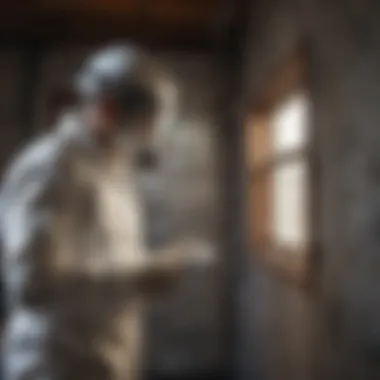Materials:
- Protective gloves: 2 pairs of Nitrile gloves
- Respirator mask: N95 rated mask for respiratory protection
- Plastic sheets: 10 x 10 feet for containment of work area
- Duct tape: 1 roll for securing plastic sheets
- Spray bottle: 1 for misting surfaces
- Asbestos testing kit: Purchase from reputable supplier
- Sealant: PVA-based sealant for encapsulation
- Plastic bags: Sealable for disposal of materials
DIY Steps:
- Prepare the Work Area: Lay out plastic sheets and seal edges with duct tape to contain debris.
- Gear Up: Put on protective gloves and respirator mask before starting any work.
- Sample Collection: Follow instructions on asbestos testing kit for collecting samples.
- Testing Process: Utilize testing kit per manufacturer's guidelines to check for asbestos presence.
- Interpret Results: Analyze test results to determine asbestos presence in siding.
- Seal or Dispose: If positive, seal affected area with sealant or dispose of siding properly.
Technical Aspects:
- Timing: Plan for a quiet time in the property to avoid disturbances during testing.
- Tools: Ensure proper functioning of testing kit and sealant for effective results.
- Techniques: Follow precise instructions in testing kit to prevent contamination.
DIY Project Process:


- Sample Collection: Extract samples cautiously to prevent releasing fibers into the air.
- Testing Procedure: Conduct tests in a well-ventilated area according to kit instructions.
- Safety Measures: Adhere to safety protocols to protect against asbestos exposure.
Troubleshooting Tips:


- If samples are inconclusive, collect additional samples or consult a professional.
- In case of positive results, seek guidance on proper removal or sealing techniques.
Understanding Asbestos in Siding


In the realm of homeownership, understanding asbestos in siding holds paramount significance, especially concerning health and safety. Asbestos, a naturally occurring mineral known for its heat resistance and durability, was extensively used in construction materials, including siding, due to its insulating properties. However, asbestos fibers, when inhaled, pose severe health risks, such as respiratory issues and cancer, leading to the urgent need to address its presence in siding. In this comprehensive guide, we delve deep into the intricacies of identifying and dealing with asbestos in siding, equipping homeowners with essential knowledge for safeguarding their well-being and property value.
What is Asbestos?
Asbestos is a mineral consisting of thin, microscopic fibers that possess exceptional resistance to heat, electricity, and corrosion. These unique properties made asbestos a popular choice for various construction products, including siding. Its robust nature allowed for durable and fire-resistant siding, contributing to its widespread use in the past. Despite its practical advantages, the health hazards associated with asbestos exposure have led to heightened awareness and regulatory measures to protect individuals from its harmful effects, emphasizing the need to understand its presence in residential siding.
Historical Use of Asbestos in Siding
Historically, asbestos found extensive application in siding due to its desirable properties and affordability. During the mid-20th century, asbestos-containing materials, including siding products, were commonly installed in homes, reflecting the prevailing trend in construction practices. The incorporation of asbestos in siding offered durability and weather resistance, aligning with the construction standards of the time. However, as the adverse health impacts of asbestos exposure became evident, regulations emerged to restrict its use, underscoring the importance of recognizing its historical presence in siding to mitigate health risks and ensure safe residential environments.
Health Risks Associated with Asbestos
As we delve into the intricacies of determining if your siding contains asbestos, understanding the health risks associated with this mineral is paramount. Exposure to asbestos in siding can lead to severe health consequences, emphasizing the critical need for accurate identification. By shedding light on the potential health hazards, individuals can take proactive measures to safeguard their well-being.
Respiratory Issues
One of the primary health risks linked to asbestos exposure through siding is respiratory issues. Inhalation of asbestos fibers can cause significant damage to the respiratory system, leading to conditions such as asbestosis and lung cancer. These microscopic fibers, when airborne, can be easily ingested, posing a serious threat to lung health. Developing a thorough understanding of the respiratory risks associated with asbestos is crucial for making informed decisions regarding testing and removal procedures.
Cancer Risk
Moreover, the risk of cancer due to asbestos exposure cannot be understated. Asbestos in siding has been linked to various forms of cancer, including mesothelioma, lung cancer, and laryngeal cancer. The carcinogenic properties of asbestos fibers make it a potent risk factor for developing cancer, underscoring the importance of early detection and mitigation efforts. Recognizing the correlation between asbestos exposure and cancer risk is essential for prioritizing health and safety when dealing with potentially contaminated siding.
Signs Your Siding May Contain Asbestos
In the realm of property maintenance and health considerations, identifying whether your siding contains asbestos holds paramount importance. Asbestos in siding poses significant health risks that necessitate prompt detection and appropriate action. By delving into the indicators that your siding may harbor asbestos, you can safeguard yourself, your loved ones, and your property from potential harm. This section serves as a crucial gateway to understanding the potential presence of asbestos in your siding, empowering you to make informed decisions that prioritize safety and well-being.
Age of the Property
One key aspect to consider when assessing the likelihood of asbestos in your siding is the age of the property. Older structures, especially those built before the 1980s, are more likely to contain materials with asbestos, including siding. This is due to the historical use of asbestos in construction, particularly in the mid-20th century. Therefore, if your property is several decades old, it raises the possibility of asbestos-containing materials, necessitating a more in-depth inspection to ensure safety.
Visual Inspection
A visual inspection of your siding can often provide initial clues regarding the presence of asbestos. By honing in on specific aspects such as texture, color, and fibrous appearance, you can glean valuable insights that signal potential asbestos content within your siding.
Texture
When scrutinizing the texture of your siding, pay attention to any irregularities or unusual surfaces. Asbestos-containing materials may exhibit a distinct texture that differs from modern alternatives. The presence of a rough, uneven surface or a texture resembling crumbled paper could indicate asbestos content. Such textures are characteristic of older siding materials that could potentially pose health risks.
Color
The color of your siding can also be indicative of asbestos presence. Certain shades commonly associated with older asbestos-containing materials, such as shades of gray, brown, or white, may hint at the presence of this hazardous mineral. If your siding displays hues that align with traditional asbestos colors, further investigation is warranted to ascertain the presence of asbestos.
Fibrous Appearance
Inspecting the fibrous appearance of your siding is instrumental in identifying potential asbestos content. Asbestos fibers, when present in siding, can create a fibrous look that sets them apart from other materials. A fibrous appearance characterized by visible strands or fibers within the siding material may indicate the presence of asbestos. If your siding exhibits this distinct feature, it is advisable to seek professional assistance to conduct thorough testing and confirm the presence of asbestos particles.
Testing for Asbestos in Siding
Asbestos in siding is a serious concern due to its potential health risks. Testing for asbestos is a crucial step in safeguarding your well-being and that of your property. By accurately identifying the presence of asbestos, you can make informed decisions regarding remediation and ensure a safe living environment for you and your family.
Professional Inspection
Professional inspection for asbestos in siding is a recommended approach for accurate and reliable results. Certified asbestos inspectors have the expertise and specialized equipment to conduct thorough assessments. They follow strict protocols to collect samples safely and analyze them in accredited laboratories. Professional inspections provide detailed reports outlining the extent of asbestos contamination, if any, and the recommended course of action for mitigation.
DIY Testing Kits
DIY testing kits offer a convenient yet less conclusive method for detecting asbestos in siding. These kits typically involve collecting samples following instructions provided and sending them to a lab for analysis. While DIY kits may provide preliminary insights, their results may not always be as comprehensive or reliable as those from professional inspections. It's essential to follow instructions meticulously to ensure accurate sampling and avoid any potential health risks associated with mishandling asbestos-containing materials.
Safe Removal of Asbestos Siding
Safe removal of asbestos siding is a critical aspect of maintaining a safe and healthy home environment. Asbestos siding, if not handled properly, can pose significant health risks to occupants. Therefore, understanding the process of safely removing asbestos siding is paramount. One key element to consider is hiring certified abatement professionals for this task. These professionals are trained in the safe removal and disposal of asbestos materials, ensuring that the process is carried out according to established safety guidelines. By hiring certified abatement professionals, homeowners can have peace of mind knowing that the removal process is being handled competently and in compliance with regulations. Moreover, certified abatement professionals have the necessary equipment and expertise to minimize the spread of asbestos fibers during the removal process. They employ specialized techniques to contain and remove asbestos-containing materials safely. This prevents the risk of exposure to asbestos fibers, safeguarding the health of both the occupants and the workers involved in the removal process. The benefits of hiring certified abatement professionals extend beyond ensuring a safe removal process. These professionals can also provide guidance on additional measures to take to prevent recontamination and ensure the property is free from asbestos hazards. Additionally, they can assist homeowners in understanding the importance of regular inspections and maintenance to prevent future asbestos-related issues. When it comes to safe removal of asbestos siding, homeowners should prioritize working with certified abatement professionals to guarantee a thorough and secure removal process that protects the health of everyone involved and prevents potential risks of asbestos exposure.
Hiring Certified Abatement Professionals
Hiring certified abatement professionals is a crucial step in ensuring the safe removal of asbestos siding from a property. These professionals have undergone rigorous training and certification processes to equip them with the knowledge and skills required for handling asbestos-containing materials. Certified abatement professionals are well-versed in asbestos removal procedures, safety protocols, and disposal regulations. They have a thorough understanding of the health risks associated with asbestos exposure and take necessary precautions to mitigate these risks during the removal process. By hiring certified abatement professionals, homeowners can benefit from their expertise in conducting thorough inspections to identify all areas where asbestos siding may be present. This enables them to create a comprehensive removal plan tailored to the specific needs of the property. Additionally, certified abatement professionals possess specialized equipment and tools that enable them to carry out the removal process efficiently and effectively. They follow strict containment procedures to prevent the spread of asbestos fibers and ensure the safe disposal of contaminated materials. Overall, hiring certified abatement professionals offers homeowners peace of mind knowing that the asbestos removal process is being managed by qualified and experienced individuals who prioritize safety and adherence to regulatory standards.
Legal Regulations
In addition to hiring certified abatement professionals, homeowners must also be aware of the legal regulations governing the removal of asbestos siding. Asbestos is a hazardous material that is regulated by federal, state, and local authorities to protect public health and the environment. Before initiating any asbestos removal activities, homeowners should familiarize themselves with the relevant regulatory requirements in their area. This may include obtaining permits for asbestos removal, adhering to specific procedures for handling and disposal, and ensuring compliance with safety standards. Failure to comply with legal regulations regarding asbestos removal can result in severe penalties and fines. Homeowners should prioritize working with certified abatement professionals who are well-versed in these regulations and can ensure that the removal process is carried out in full compliance with the law. Furthermore, legal regulations also outline insurance requirements and liability considerations related to asbestos removal. Homeowners should review their insurance policies to determine coverage for asbestos-related activities and liabilities. By understanding and adhering to legal regulations governing asbestos removal, homeowners can avoid legal issues, protect their health and safety, and ensure that the removal process is conducted responsibly and ethically.





